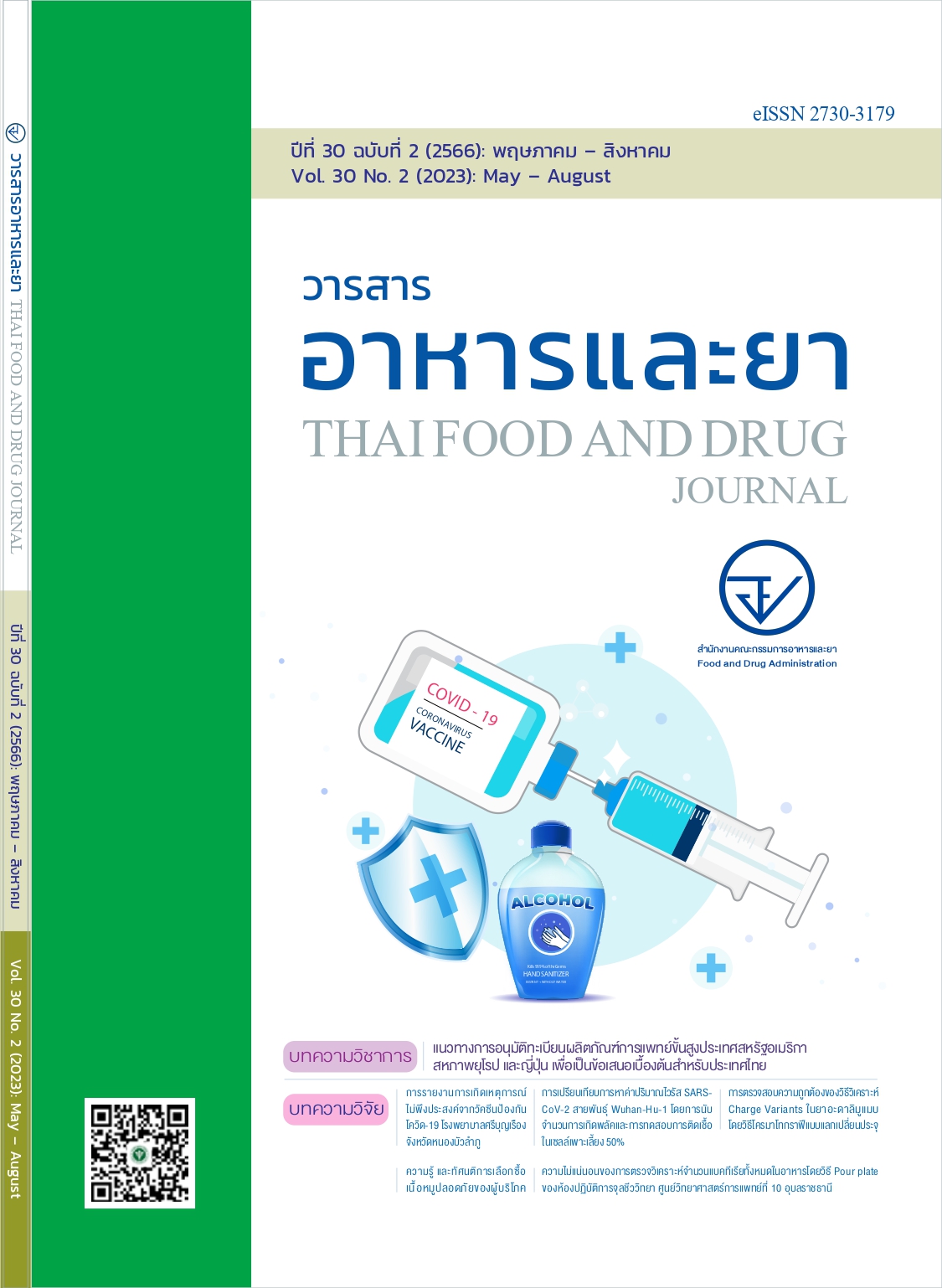การตรวจสอบความถูกต้องของวิธีวิเคราะห์ Charge Variants ในยาอะดาลิมูแมบ โดยวิธีโครมาโทกราฟีแบบแลกเปลี่ยนประจุ
Main Article Content
บทคัดย่อ
ความสำคัญ: ยาอะดาลิมูแมบชนิด fully human recombinant immunoglobulin G1 ออกฤทธิ์ในการยับยั้ง TNF-α ปัจจุบันนี้มีทั้งยาต้นแบบและยาชีววัตถุคล้ายคลึง ใช้รักษาโรคข้ออักเสบรูมาตอยด์และการอักเสบต่างๆ ของร่างกาย ซึ่งผลิตโดยใช้เทคโนโลยีชีวภาพ มีโอกาสที่จะได้ประจุของยา (charge variants) ที่แตกต่างกันในแต่ละครั้งของการผลิต การเปลี่ยนแปลงอาจส่งผลต่อการออกฤทธิ์ทางชีวภาพ ระบบภูมิคุ้มกันและความคงตัวของผลิตภัณฑ์ได้ ดังนั้นการควบคุมคุณภาพจึงมีความสำคัญเพื่อให้ผู้ป่วยได้รับยาตามมาตรฐาน การวิเคราะห์ charge variants มักใช้เทคนิคโครมาโทกราฟีแบบแลกเปลี่ยนประจุ โดยใช้หลักการเพิ่มความเข้มข้นของเกลือ หรือเพิ่ม pH เพื่อแยกสารตามประจุที่แตกต่างกัน ซึ่งใช้ในการวิเคราะห์ได้ทั้งเชิงคุณภาพและเชิงปริมาณ
วัตถุประสงค์: ทดสอบความถูกต้องของวิธีวิเคราะห์ charge variants ของยาอะดาลิมูแมบ ด้วยเทคนิคโครมาโท กราฟีแบบแลกเปลี่ยนประจุ ตาม ICH guidelines เพื่อนำมาใช้เป็นวิธีมาตรฐานในการวิเคราะห์ยาอะดาลิมูแมบ
วิธีการวิจัย: ทดสอบความถูกต้องของวิธีวิเคราะห์ เช่น ความจำเพาะ ความเที่ยง ความแม่น ความเป็นเส้นตรง การตรวจวัดเชิงปริมาณและขีดกำจัดในการตรวจพบ และความคงทนของวิธี
ผลการศึกษา: พบว่ามีวิธีนี้มีความจำเพาะ มีความเป็นเส้นตรงในช่วง 1.00 ถึง 10.00 mg/ml มี %RSD ของการทำซ้ำในวันเดียวกันและต่างวัน ไม่เกิน 5 มีค่าความเที่ยงอยู่ในช่วง 90-110% และสามารถตรวจวัดเชิงปริมาณได้ 2.50 mg/ml มีขีดจำกัดของการตรวจพบ 0.70 mg/ml และวิธีมีความคงทนเมื่อเปลี่ยนแปลงระยะเวลาในการเก็บรักษาสารละลายเฟสเคลื่อนที่
สรุป: วิธีนี้มีความจำเพาะ ความแม่น ความเที่ยง ความเป็นเส้นตรงตลอดช่วงที่วิเคราะห์และวิธีมีความคงทน เหมาะสมนำมาใช้เป็นวิธีมาตรฐานในการควบคุมคุณภาพของยาอะดาลิมูแมบเพื่อประกอบการขึ้นทะเบียนจำหน่ายในประเทศ
Article Details

อนุญาตภายใต้เงื่อนไข Creative Commons Attribution 4.0 International License.
เอกสารอ้างอิง
Vena GA, Cassano N. Drug focus: adalimumab in the treatment of moderate to severe psoriasis. Biologics 2007;1(2):93-103.
Lu X, Hu R, Peng L, Liu M, Sun Z. Efficacy and safety of adalimumab biosimilars: Current Critical Clinical Data in Rheumatoid Arthritis. Frontiers in immunology 2021;12.
Ellis CR, Azmat CE. Adalimumab. In: StatPearls [Internet]. 2022 [cite 2022 Jul 31]. Available from: https://www.ncbi.nlm.nih.gov/books/NBK557889/
Accessdata.fda.gov. [Internet]. 2022 [cited 2022 Jul 31]. Available from: https://www.accessdata.fda.gov/drugsatfda_docs/label/2008/125057s0110lbl.pdf
Exemptia Adalimumab EMPOWERING YOU. Exemptia - World’s First Adalimumab Biosimilar [Internet].2022 [cited 2022 Aug 14]. Available from: https://exemptia.com/
U.S. Food and Drug Administration. Biosimilar Drug Information [Internet]. 2022 [cited 2022 Aug 14]. Available from: https://www.fda.gov/drugs/biosimilars/biosimilar-product-information
Kaur R, Borgayari D, Rathore A. Impact of media components on CQAs of monoclonal antibodies. BioPharm International 2017;30(9)40-6.
Harris R, Shire S, Winter C. Commercial manufacturing scale formulation and analytical characterization of therapeutic recombinant antibodies. Drug Development Research 2004;61(3):137-54.
Huang L, Lu J, Wroblewski V, Beals J, Riggin R. In Vivo Deamidation Characterization of Monoclonal Antibody by LC/MS/MS. Analytical Chemistry 2005;77(5):1432-439.
Khawli L, Goswami S, Hutchinson R, Kwong Z, Yang J, Wang X et al. Charge variants in IgG1. mAbs 2010;2(6):613-24.
Singh S, Narula G, Rathore A. Should charge variants of monoclonal antibody therapeutics be considered critical quality attributes?. Electrophoresis 2016;37(17-18):2338-46.
Hermeling S, Crommelin D, Schellekens H, Jiskoot W. Structure-immunogenicity relationships of therapeutic proteins. Pharmaceutical Research 2004;21(6):897-903.
Monoclonal antibodies for human use. In: European pharmacopoeia 10.0thed. Strasbourg: EDQM Council of Europe; 2020. P.878-880
Santora L, Krull I, Grant K. Characterization of recombinant human monoclonal tissue necrosis factor-α antibody using cation - exchange HPLC and capillary isoelectric focusing. Analytical Biochemistry 1999;275(1):98-108.
Ahrer K, Jungbauer A. Chromatographic and electrophoretic characterization of protein variants. Journal of Chromatography B 2006;841(1-2):110-22.
Du Y, Walsh A, Ehrick R, Xu W, May K, Liu H. Chromatographic analysis of the acidic and basic species of recombinant monoclonal antibodies. mAbs 2012;4(5):578-85.
Fekete S, Beck A, Fekete J, Guillarme D. Method development for the separation of monoclonal antibody charge variants in cation exchange chromatography, Part II: pH gradient approach. Journal of Pharmaceutical and Biomedical Analysis 2015;102:282-9.
Farnan D, Moreno G. Multiproduct High-Resolution Monoclonal Antibody Charge Variant Separations by pH Gradient Ion-Exchange Chromatography. Analytical Chemistry 2009;81(21):8846-857.
Talebi M, Nordborg A, Gaspar A, Lacher N, Wang Q, He X et al. Charge heterogeneity profiling of monoclonal antibodies using low ionic strength ion-exchange chromatography and well-controlled pH gradients on monolithic columns. Journal of Chromatography A 2013;1317:148-54.
Ahamed T, Nfor B, Verhaert P, van Dedem G, van der Wielen L, Eppink M et al. pH-gradient ion-exchange chromatography: An analytical tool for design and optimization of protein separations. Journal of Chromatography A 2007;1164(1-2):181-88.
ICH Harmonised Tripartite Guideline. Validation of analytical procedures: text and methodology (Q2(R1)). London: European Medicines Agency; 2005.
Center for Drug Evaluation and Research (CDER). Reviewer guidance, validation of Chromatographic methods [Internet]. U.S. Food and Drug Administration. FDA; [cited 2023 Feb 22]. Available from: https://www.fda.gov/media/75643/download
สำนักยา สำนักงานคณะกรรมการอาหารและยา. คู่มือและหลักเกณฑ์การขึ้นทะเบียนตำรับยาชีววัตถุคล้ายคลึง (Biosimilars). กรุงเทพฯ: สำนักพิมพ์อักษรกราฟฟิคแอนด์ดีไซน์; 2561.
Bandyopadhyay S, Mahajan M, Mehta T, Singh AK, Gupta AK, Parikh A, et al. Physicochemical and functional characterization of a biosimilar adalimumab ZRC-3197. Biosimilars 2015;5:1-18.
Rea JC, Moreno GT, Lou Y, Farnan D. Validation of a pH gradient-based ion-exchange chromatography method for high-resolution monoclonal antibody charge variant separations. Journal of Pharmaceutical and Biomedical Analysis 2011;54(2):317–23.
Mohan C. A guide for the preparation and use of buffers in biological s ystems [Internet]. [cited 2023 Feb 26]. Available from: https://www.med.unc.edu/pharm/sondeklab/wp-content/uploads/sites/868/2018/10/buffers_calbiochem.pdf
Fekete S, Beck A, Veuthey J, Guillarme D. Ion-exchange chromatography for the characterization of biopharmaceuticals. Journal of Pharmaceutical and Biomedical Analysis 2015;113:43-55.


